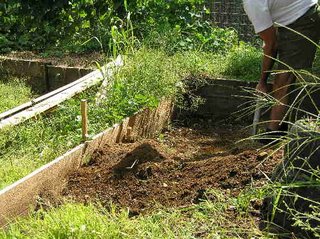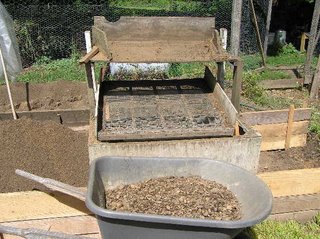Out in the Garden
So.....
This summer, one of the projects I have wanted to work on is adding a couple of raised beds in our vegetable garden. We have a vegatable garden surrounded in chicken wire. The chicken wire helps keep out the wood chuck, who likes all the leafy vegatables and young shoots. But it is really there for the the chickens in the winter. We let them free range in the summer and they live in our unheated greenhouse during the winter.
Last year was the first year of the greenhouse, and I found that I miscalulated the winter sun and we want a different orientation. Luckily, the greenhouse is a simple temporary structure and we planned to move it every year anyway. That's the greenhouse on the left. It's a neat structure built on a welded wire frame, but I'll talk about that some other time. We want turn the greenhouse 90 degrees for this season so it has more eastern exposure. With the sun taking a lower path in the sky and the hill to the west, we get better sun from the east during the winter.

To make that happen, I am building another raised bed perpandicular to the existing greenhouse. That will allow me to put the new greenhouse on two end raised beds for the winter. That's the area to the right in this picture. That area is currently full of weeds, the end bed was fallow this year.

My philosophy on the rasied beds is by moving the soil from the path to the planting bed, I can raise the bed enough to make it much easier to work. I generally dig the paths 8 to 10 inches below grade and support them with hemlock planks. I get the hemlock from a local farmer who has a rough cut sawmill operation on the side. Since the paths are about half the garden, the beds are raised 8 to 10 inches above grade. This height differential between the paths and the bed allows me to tend the garden without getting on my hands and knees. It's a real back saver all season. It also improves drainage, not like I had a problem with drainage, but well drained is better than swampy.

The other significant part of any gardening here is we are living in the streambed of a prehistoric river. We have a little topsoil, but it is full of gravel, about one third. And below the six inches of topsoil is sand and gravel. Hence the sifter in the first picture. I pass all the soil for the rasied bed through the sifter to get the loamy soil I like for the garden. It's a lot of work, but the soil is much easier to work, it removes all the weed roots and I always have projects around the foundation that need gravel.
So, you're wondering, how does this fit into the whole rental market theme of my blog??? Well, I admit, it's a bit of a tangent. But in a real sense, part of what I am marketing here is rural living. We have chickens in the yard that provide fresh eggs for the common kitchen. We have blustery winter nights that make us thankful for the sound country farmhouse we live in. And, in the summer, we have gardens that provide aesthetica appeal even if my tennants aren't interested in participating more materially. Part of my marketing philosophy is that we are providing an entire lifestyle here. A comfortable living arrangement where my tennants can feel they are living in the landscape as muc as suits them.


0 Comments:
Post a Comment
<< Home